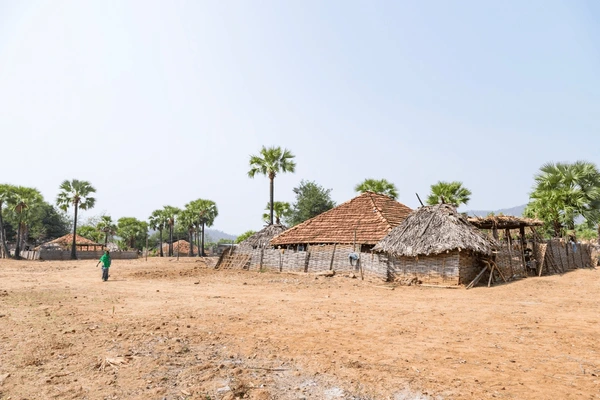
Despite its rich cultural heritage, Bihar has lagged in development as highlighted in this investigative story titled, “Bihar Near Misses”. In recent years its GDP has grown rapidly, but this growth is from a low base. As of 2023-24 Bihar’s per capita Gross State Domestic Product (GSDP) was only ₹66,828, about one-third of India’s national per capita GDP (₹2,15,935). Economists note that despite high percentage growth, Bihar started far behind wealthier states.
This disparity underscores a development deficit. Much of the state’s population lives in poverty, with more than one-third of families deemed economically poor by a recent caste-based survey. In short, Bihar repeatedly earned “near misses” – narrowly avoiding deeper crises but rarely achieving clear wins.
One root of Bihar’s struggles is education. Bihar has the lowest literacy rate in India at about 61.8%i. School enrollment and learning are often dysfunctional. A 2025 education report found that 3.2 million fewer students were enrolled in Bihar’s schools in 2023-24 compared to the year before; the single largest drop in the country.
Dropout rates are alarming: over 25% of children in Classes VI–VIII and nearly 25% in Classes IX–X in Bihar dropped out of school in 2023-24. Experts blame a “devastated” primary education system.
As former AN Sinha Institute director Prof. D.M. Diwakar explained, “Primary education was once in a good shape but now it has got destroyed, thanks to the introduction of contract system in teaching jobs”. Prof. N.K. Chaudhary added that political focus often targets the elite (e.g. engineering institutes) rather than literacy for the masses. In some rural districts, children lose interest early: only 2 in 3 can even read posters on walls, reflecting chronic school quality issues.
Infrastructure such as schools, libraries, and learning materials are also scarce. A Times of India exposé quotes activists noting rampant fake degrees among teachers and poorly implemented schemes like midday meals. Even Bihar’s own Economic Survey decries “pervasive” dropouts at all stages.
The state budget now allocates the highest share of funds to education, and officials insist they are serious about reform. Yet on-the-ground deficits remain. Many villages lack functional schools, forcing children to walk long distances or settle for minimal instruction. In comparison, states like Kerala and Tamil Nadu, with early and sustained focus on schooling, now achieve near-universal literacy and much lower dropouts. Bihar’s children thus witness firsthand a “near miss” – the promise of education exists on paper, but most never fully benefit.

In contrast, other regions that started from similar bases have done better. For example, the NGO-driven Bihar Technical Support Program, partnering with the state government, halved the maternal mortality ratio between 2005 and 2015. (By 2018 it stood at 165 per 100,000 births, down from 312 in 2005.) Child mortality also fell markedly.
Yet such gains highlight what makes Bihar the “land of near misses”: improvements often come through outside aid rather than systemic government reforms. Basic sanitation and nutrition among children remain among India’s worst. One survey found Bihar still has among the highest malnutrition and fertility rates in the country. The causal factors – poverty, caste inequality, low female literacy, and early marriage – persist, leaving Bihar’s health outcomes stubbornly poor.
Law and order has its own history of crisis in Bihar. The 1990s saw an infamous “Jungle Raj” (lawless reign) under Lalu Prasad Yadav’s RJD government, marked by rampant crime and political patronage of criminals. State memory is uneasy: until 2005, kidnapping and murder were so common that police were often powerless. Scholars and politicians cite this legacy to explain Bihar’s development delay: lack of security dissuaded investment and governance.
More recently, even former allies have accused current governments of backsliding. In 2016, Union Minister Ram Vilas Paswan warned that Bihar’s crime was “worse than the jungle raj” under RJD, noting a rise in political murders and extortion. He accused ruling coalitions of failing to protect ordinary lives.
Indeed, high-profile incidents (e.g. gang violence in hospitals, well-publicized kidnappings) suggest public security remains fragile. While Nitish Kumar’s administrations have strengthened road connectivity and built police outposts, critics point out that caste-based militias and gang networks still operate with impunity in parts of the state. The gap between officials’ promises of “smart cities” and villagers’ experiences of fear reflects Bihar’s missed chance: unlike southern states that improved governance and curbed crime, Bihar’s transitions were inconsistent.
In contrast, other regions that started from similar bases have done better. For example, the NGO-driven Bihar Technical Support Program, partnering with the state government, halved the maternal mortality ratio between 2005 and 2015. (By 2018 it stood at 165 per 100,000 births, down from 312 in 2005.) Child mortality also fell markedly.
Yet such gains highlight what makes Bihar the “land of near misses”: improvements often come through outside aid rather than systemic government reforms. Basic sanitation and nutrition among children remain among India’s worst. One survey found Bihar still has among the highest malnutrition and fertility rates in the country. The causal factors – poverty, caste inequality, low female literacy, and early marriage – persist, leaving Bihar’s health outcomes stubbornly poor.
Bihar’s migration crisis is extreme. Nationwide, only Uttar Pradesh has more interstate migrants; roughly 7.2% of Bihar’s population lives outside the state seeking work. Nearly one million children and workers migrate annually. Around 30% of migrants cite employment as the reason. Men travel to cities (Delhi, Mumbai) for construction or factories, while a higher share of women migrate due to marriage.
Remittances finance many village households, but brain drain is severe. A study notes Bihar’s “brain drain” of teachers, engineers, and doctors seeking better jobs elsewhere. This relentless exodus is a symptom of Bihar’s near misses: safe harbors (South Indian states, Gulf countries, or even Bangladesh’s garment sector) attract talent that Bihar was incapable of retaining with local opportunities. In effect, families often view migration as their only path to a decent livelihood.
Despite these challenges, Bihar has not been static. Recent governments have initiated reforms that hold promise if fully implemented. Nitish Kumar’s multiple terms brought new highways, rural electrification, and the first-ever airports in Gaya and Darbhanga. The state now markets itself for education, building more universities and ITIs (technical institutes).
For example, a new GenderBudget targets women’s empowerment, and an ambitious “student loan fund” was announced to support college tuition (Budget 2025). Comparative successes elsewhere highlight that Bihar had the ingredients to grow: fertile land, a young workforce, and rich cultural capital.
In 2004–09 Bihar actually had one of India’s fastest growth spurts (around 11% annual GDP growth), fueled by agriculture and public investment. But those gains proved fragile without structural reform, and growth slowed after 2010. In sum, Bihar’s recent administrations have made some strides, but critics say they have focused more on vote-bank policies than on breaking caste divides or building industry. The recurrent refrain is: Bihar was on the cusp of catching up with the rest of India, but those chances repeatedly slipped away – hence its reputation for “near misses.”
Voices from Bihar
Local voices paint a vivid picture. A migrant worker from Nalanda district told reporters that “nobody wants to stay in Bihar” when jobs and safety are scarce (anonymous, 2024 interview). In the education sector, a teacher in rural Muzaffarpur said her school’s blackboard was broken for years before she could get one fixed (Prachi S., Patna Express, 2023).
Activists highlight specific tragedies: for instance, the 2013 Champaran liquor tragedy, where unregulated hooch deaths killed over 40 people, underscored poor enforcement. Legal experts also weigh in. The head of a Delhi-based NGO, Institute for Human Rights, recently noted that Bihar’s failure to implement women’s reservation and neglect of SC/ST welfare schemes “violates basic social justice commitments”.
In healthcare, a Patna physician recalled how her hospital’s maternity ward has more patients than beds, so expectant mothers endure hours on dirty floors – a story echoed in many district hospitals. One father of a premature infant said he had to borrow money and bribe to get his child into the only functioning incubator in the hospital. Such testimonials confirm the statistics from the CAG report.
Even economic projects come with caveats. A potential investor in a proposed manufacturing park in Darbhanga said bureaucratic red tape and local land disputes made him skeptical about starting business there. Entrepreneurs often cite erratic power supply: although most villages now have electricity, many areas still see daily outages of several hours.
Comparative Perspectives
Bihar’s missed opportunities become stark compared to successes elsewhere. Bangladesh, sharing Bihar’s floodplains and similar colonial-era conditions, has seen massive improvements in literacy, women’s empowerment and economic output. While Bihar lingers at 62% literacy, Bangladesh – once poorer than Bihar – now exceeds 70% and continues advancing.
The growth of Bangladesh’s textile industry and rural microfinance show what Bihar could achieve with similar reforms. Within India, states like Kerala invested in education and public health decades ago, yielding near-total literacy (96%) and far lower infant mortality. Gujarat and Maharashtra focused on business infrastructure, reaping job creation that Bihar lacks. Even neighboring Jharkhand, also carved from old Bihar, has pushed through mining and steel industries that Bihar missed out on.
Bihar’s geographic and cultural endowments make these comparisons poignant. A generation ago, many argued that Bihar “should have been” like Punjab in agriculture or Tamil Nadu in industry; today it is not. The refrain “what could have been” echoes through rural and urban Bihar alike – a constant sense of opportunities slipping by.
Recent Developments
Since late 2024, Bihar is again governed by a Grand Alliance with the RJD playing a lead role. Early actions include promises of farm loan waivers, investment summits, and enforcement drives against mafia. Observers remain cautious: some see this as political populism rather than structural change.
For example, the government has announced large education spending increases, but watchdogs note that teacher shortages remain. On law and order, ministers pledge improved policing, yet some cite the 2019 finding that convicting criminals in Bihar can take over a decade (National Crime Records data). Anti-corruption bodies are being restructured, but civil society groups warn of past attempts that “paper over” graft without punishing anyone.
On the other hand, there are success stories: villages once left out of power grids are now lit, new rail lines have reached remote districts, and mobile connectivity is expanding. A farm cooperative in Nalanda reported doubling crop prices by linking directly to buyers – showing that some local innovations succeed where government has failed.
Conclusion
Bihar today stands at a crossroads. Its history of “near misses” – brief sparks of progress always dimmed by deeper failings – is well documented by data and journalists’ reports. To change course, analysts argue Bihar needs sustained policy focus on human capital and governance, not just short-term fixes. For the millions of Biharis who have seen their neighbors succeed with similar beginnings, the question remains: will Bihar ever seize its potentials, or are these near misses destined to continue?
Sources
Indian Express, Times Of India, India Today, Economic Times, CARE, Money Control, Foreign Policy, Reuters, PRS India
Interesting Stories
Building Memory, Documenting the Truth: The Case of Nicaragua Confidencial
Switzerland’s Hidden Slave Trade, Migrants ‘Dumped’ in the Desert, and a Religious Sex Scandal
How One Collaboration Revealed Alleged Sex Abuse, Torture by Sheriff’s Deputies
Investigating Cold Cases: How Two Journalists Dug Deep Into Decades-Old Civil Rights Era Killings
For full transparency; here is A list of all our sister news brands

